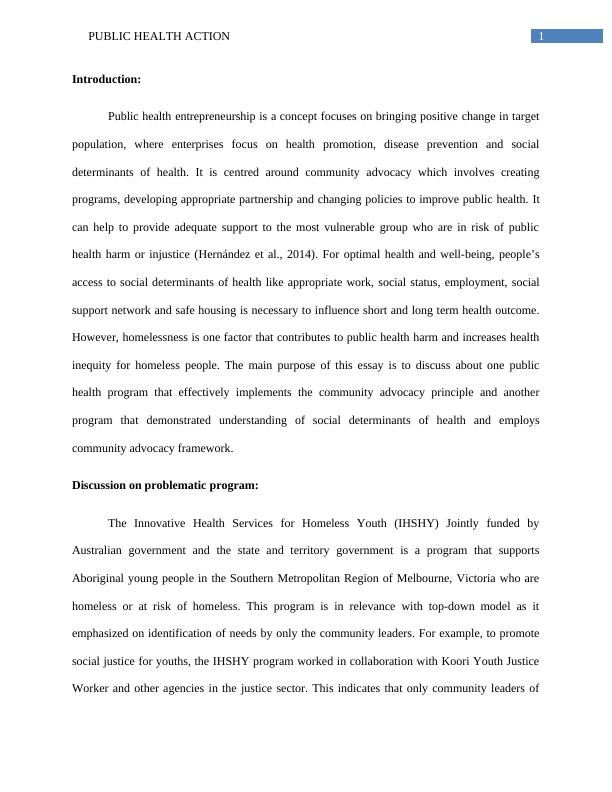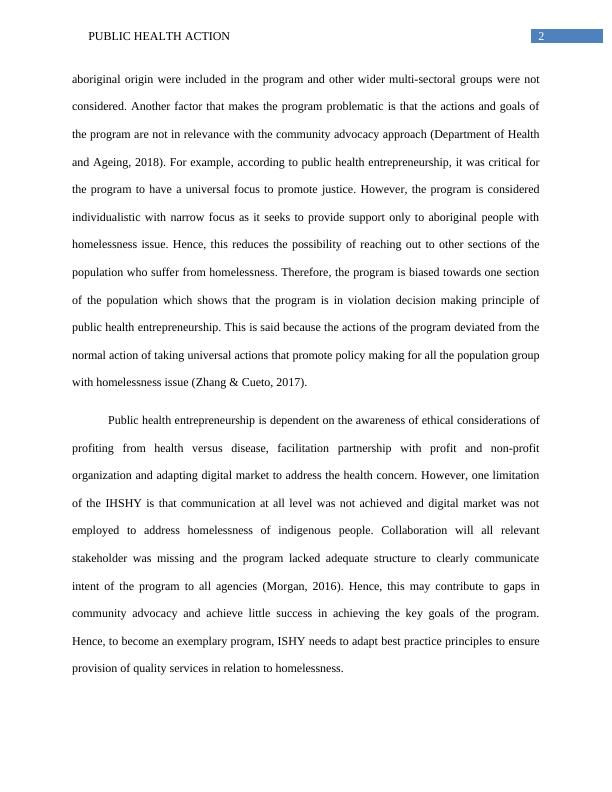Evaluation of Public Health Programs Addressing Homelessness in Australia
Added on 2023-03-17
9 Pages2279 Words47 Views
Running head: PUBLIC HEALTH ACTION
Public health action
Name of the student:
Name of the University:
Author’s note
Public health action
Name of the student:
Name of the University:
Author’s note

1PUBLIC HEALTH ACTION
Introduction:
Public health entrepreneurship is a concept focuses on bringing positive change in target
population, where enterprises focus on health promotion, disease prevention and social
determinants of health. It is centred around community advocacy which involves creating
programs, developing appropriate partnership and changing policies to improve public health. It
can help to provide adequate support to the most vulnerable group who are in risk of public
health harm or injustice (Hernández et al., 2014). For optimal health and well-being, people’s
access to social determinants of health like appropriate work, social status, employment, social
support network and safe housing is necessary to influence short and long term health outcome.
However, homelessness is one factor that contributes to public health harm and increases health
inequity for homeless people. The main purpose of this essay is to discuss about one public
health program that effectively implements the community advocacy principle and another
program that demonstrated understanding of social determinants of health and employs
community advocacy framework.
Discussion on problematic program:
The Innovative Health Services for Homeless Youth (IHSHY) Jointly funded by
Australian government and the state and territory government is a program that supports
Aboriginal young people in the Southern Metropolitan Region of Melbourne, Victoria who are
homeless or at risk of homeless. This program is in relevance with top-down model as it
emphasized on identification of needs by only the community leaders. For example, to promote
social justice for youths, the IHSHY program worked in collaboration with Koori Youth Justice
Worker and other agencies in the justice sector. This indicates that only community leaders of
Introduction:
Public health entrepreneurship is a concept focuses on bringing positive change in target
population, where enterprises focus on health promotion, disease prevention and social
determinants of health. It is centred around community advocacy which involves creating
programs, developing appropriate partnership and changing policies to improve public health. It
can help to provide adequate support to the most vulnerable group who are in risk of public
health harm or injustice (Hernández et al., 2014). For optimal health and well-being, people’s
access to social determinants of health like appropriate work, social status, employment, social
support network and safe housing is necessary to influence short and long term health outcome.
However, homelessness is one factor that contributes to public health harm and increases health
inequity for homeless people. The main purpose of this essay is to discuss about one public
health program that effectively implements the community advocacy principle and another
program that demonstrated understanding of social determinants of health and employs
community advocacy framework.
Discussion on problematic program:
The Innovative Health Services for Homeless Youth (IHSHY) Jointly funded by
Australian government and the state and territory government is a program that supports
Aboriginal young people in the Southern Metropolitan Region of Melbourne, Victoria who are
homeless or at risk of homeless. This program is in relevance with top-down model as it
emphasized on identification of needs by only the community leaders. For example, to promote
social justice for youths, the IHSHY program worked in collaboration with Koori Youth Justice
Worker and other agencies in the justice sector. This indicates that only community leaders of

2PUBLIC HEALTH ACTION
aboriginal origin were included in the program and other wider multi-sectoral groups were not
considered. Another factor that makes the program problematic is that the actions and goals of
the program are not in relevance with the community advocacy approach (Department of Health
and Ageing, 2018). For example, according to public health entrepreneurship, it was critical for
the program to have a universal focus to promote justice. However, the program is considered
individualistic with narrow focus as it seeks to provide support only to aboriginal people with
homelessness issue. Hence, this reduces the possibility of reaching out to other sections of the
population who suffer from homelessness. Therefore, the program is biased towards one section
of the population which shows that the program is in violation decision making principle of
public health entrepreneurship. This is said because the actions of the program deviated from the
normal action of taking universal actions that promote policy making for all the population group
with homelessness issue (Zhang & Cueto, 2017).
Public health entrepreneurship is dependent on the awareness of ethical considerations of
profiting from health versus disease, facilitation partnership with profit and non-profit
organization and adapting digital market to address the health concern. However, one limitation
of the IHSHY is that communication at all level was not achieved and digital market was not
employed to address homelessness of indigenous people. Collaboration will all relevant
stakeholder was missing and the program lacked adequate structure to clearly communicate
intent of the program to all agencies (Morgan, 2016). Hence, this may contribute to gaps in
community advocacy and achieve little success in achieving the key goals of the program.
Hence, to become an exemplary program, ISHY needs to adapt best practice principles to ensure
provision of quality services in relation to homelessness.
aboriginal origin were included in the program and other wider multi-sectoral groups were not
considered. Another factor that makes the program problematic is that the actions and goals of
the program are not in relevance with the community advocacy approach (Department of Health
and Ageing, 2018). For example, according to public health entrepreneurship, it was critical for
the program to have a universal focus to promote justice. However, the program is considered
individualistic with narrow focus as it seeks to provide support only to aboriginal people with
homelessness issue. Hence, this reduces the possibility of reaching out to other sections of the
population who suffer from homelessness. Therefore, the program is biased towards one section
of the population which shows that the program is in violation decision making principle of
public health entrepreneurship. This is said because the actions of the program deviated from the
normal action of taking universal actions that promote policy making for all the population group
with homelessness issue (Zhang & Cueto, 2017).
Public health entrepreneurship is dependent on the awareness of ethical considerations of
profiting from health versus disease, facilitation partnership with profit and non-profit
organization and adapting digital market to address the health concern. However, one limitation
of the IHSHY is that communication at all level was not achieved and digital market was not
employed to address homelessness of indigenous people. Collaboration will all relevant
stakeholder was missing and the program lacked adequate structure to clearly communicate
intent of the program to all agencies (Morgan, 2016). Hence, this may contribute to gaps in
community advocacy and achieve little success in achieving the key goals of the program.
Hence, to become an exemplary program, ISHY needs to adapt best practice principles to ensure
provision of quality services in relation to homelessness.

End of preview
Want to access all the pages? Upload your documents or become a member.
Related Documents
Marram-Ngala Ganbu Evaluation Plan Assignment 2022lg...
|14
|3123
|7
Health Promotion Program for Smoking Cessation in Aboriginal Canadianslg...
|17
|3030
|223
Drug and Alcohol Abuse among Aboriginal Youthslg...
|11
|2926
|93
Health Advocacy Strategylg...
|12
|3241
|389
Ending Homelessness Assignment PDFlg...
|6
|1531
|63
Health Promotion and Policy: Addressing Drug and Alcohol Addiction in Young Adultslg...
|14
|3503
|375
